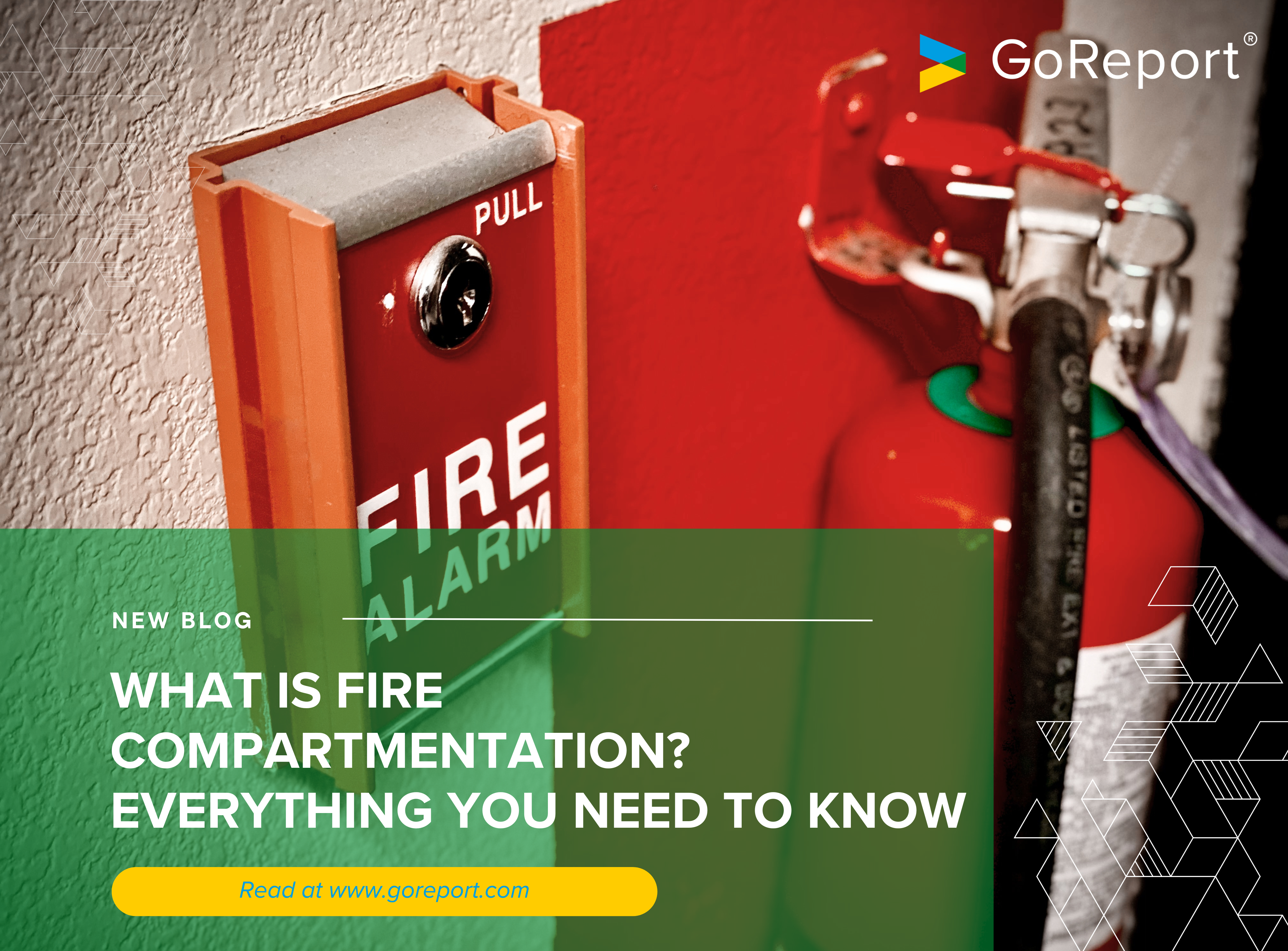What is Fire Compartmentation? Everything You Need to Know

When it comes to protecting commercial buildings, fire safety should be at the very top of your list. More active fire measures like sprinklers and alarms often take the spotlight, but one of the most essential yet often overlooked defence is fire compartmentation.
Fire compartmentation is a passive fire protection strategy that plays a big role in containing fire and smoke, protecting lives, and maintaining the structural integrity of buildings during an emergency. For surveying professionals, understanding how compartmentation works, when it’s required, and how to identify issues is key to keeping properties compliant and safe.
In this guide, we’ll walk you through everything you need to know, from the basics of what fire compartmentation is, to the regulations that govern it, how to inspect for it, and the consequences of getting it wrong. Whether you’re carrying out a risk assessment or advising clients on building modifications, this is your go-to resource for ensuring fire compartmentation standards are met.
What is Fire Compartmentation?
Fire compartmentation is the practice of dividing a building into distinct sections (compartments) using fire-resisting walls, floors, and doors. These sections are designed to contain a fire to a single area for a specified amount of time, limiting its spread and allowing those inside more time to evacuate while giving emergency services a better chance to control the fire.
Each compartment is constructed to resist fire for a set period (typically 30, 60, or 120 minutes), depending on the building’s use and layout. The materials used and the workmanship involved play a massive role in whether a compartment will perform as intended in the event of a fire.
Why Fire Compartmentation Matters for Commercial Surveyors
As a surveyor, you’re often the first line of defence when it comes to identifying risks and ensuring compliance with fire safety regulations. Whether you’re conducting pre-acquisition surveys or planned preventative maintenance assessments, understanding fire compartmentation is essential.
Common issues to look out for include:
- Incomplete or damaged fire barriers
- Unsealed service penetrations (cables, ducts, pipes)
- Poorly maintained or missing fire doors
- Inappropriate materials used during refurbishments
Even a small gap in a compartment wall can make it ineffective. That’s why surveys should include thorough inspections of walls, ceilings, voids, and plant areas.
What is the Main Objective of Fire Compartmentation?
The primary goal of fire compartmentation is to:
- Protect life by containing fire and smoke within the origin compartment, allowing occupants to evacuate safely
- Safeguard property by limiting structural damage
- Support fire-fighting efforts by preventing fire from spreading uncontrollably
- Preserve building integrity, particularly in high-risk areas such as plant rooms, lift shafts, and stairwells
In short, compartmentation is about slowing the fire down, containing the danger, and buying time. In the UK, fire compartmentation is governed primarily by:
- The Regulatory Reform (Fire Safety) Order 2005
- Approved Document B of the Building Regulations
- BS 9999 and BS 8214 (British Standards for fire safety)
These regulations state the fire resistance ratings for different types of buildings and spaces, as well as detailing inspection and maintenance requirements.
It’s worth noting that under the Fire Safety Act 2021, the duties of the Responsible Person were expanded, meaning surveyors are increasingly relied upon to assess external walls, flat entrance doors, and other fire-critical features.
When is Fire Compartmentation Needed?
Fire compartmentation is usually required in buildings where the risk of fire spreading quickly could endanger lives or cause significant damage. This includes high-rise residential buildings, commercial offices, hospitals, schools, hotels, and any other structures where people sleep, work, or gather in large numbers.
Building regulations set specific thresholds for when compartmentation is needed, such as certain floor areas, building heights, or occupancy types. It’s particularly important in escape routes, stairwells, plant rooms, and areas housing critical infrastructure. If there’s a reasonable risk of fire spread, compartmentation should be considered a mandatory safety feature.
What if a Building Does Not Have Adequate Fire Compartmentation?
The consequences can be severe if a building lacks proper fire compartmentation. Fire and smoke can spread more rapidly, compromising escape routes and increasing the risk to life. Structural damage is also more likely, which can lead to higher repair costs and prolonged building downtime.
Legally, it could expose the building owner or other ‘Responsible Person’ to enforcement action under the Regulatory Reform (Fire Safety) Order 2005, invalidate insurance coverage, or even result in prosecution depending on the severity of the incident. From a commercial surveyor’s perspective, identifying any risks early is not only a professional responsibility but also essential for safeguarding the people who live and work in the building.
Key Components of Effective Fire Compartmentation
For a fire compartmentation system to be effective, it must include:
- Fire-resisting walls and floors: Often rated to resist fire for 30 to 120 minutes
- Fire doors: Properly installed and maintained to prevent fire and smoke from spreading
- Fire-stopping: Materials used to seal joints and service penetrations
- Cavity barriers: Installed in ceiling and wall voids to prevent unseen fire spread
Each element must be installed and maintained correctly. After all, a well-designed system is only as good as its weakest point. From minor oversights to serious breaches, common failures often include:
- Missing intumescent seals around doors
- Poor fire-stopping around pipes and cables
- Unprotected structural steelwork
- Gaps left after building modifications or renovations
These failures seriously weaken the purpose of compartmentation, so recommending remedial action should always be a top priority after the survey.
How to Survey for Fire Compartmentation Issues
A proper fire compartmentation survey is key to checking a building’s fire safety and making sure it meets legal standards. These surveys should be detailed and carefully carried out to spot any weak areas in the building’s fire protection.
Start by reviewing the fire strategy drawings. These show how the building is divided into compartments, how long each section should resist fire, and where important features like fire doors, escape routes, and service risers are placed. This step gives you a clear plan and helps guide your inspection.
Then, carry out a physical inspection of all accessible areas including walls, ceilings, floors, plant rooms, and roof voids. Look for signs of damage, changes to the structure, or poor-quality repairs that could affect how well the compartment holds up in a fire. Pay special attention to joints, seals, and any areas that have been refurbished.
Breaches in fire-resisting walls or floors are a major concern, including holes for cables or pipes, structural changes that weren’t properly fire-stopped, or accidental damage. Use tools like torches, ladders, and access hatches to check hidden spaces thoroughly, making sure to detail everything you see.
Next, check all fire doors. Make sure they are in good condition, installed correctly, and fitted with the right features such as intumescent strips and self-closing mechanisms. Certified fire doors should be clearly labelled and meet the latest fire safety standards.
Service penetrations, like where pipes, ducts, or cables pass through walls or floors, should be sealed using approved fire-resistant materials. If there are gaps or poor sealing, flag them as urgent issues.
In many cases, you’ll need to recommend a third-party certified fire-stopping contractor to carry out the necessary repairs. Using certified professionals ensures the work meets the required safety standards and comes with proper documentation.
For harder-to-access areas, tools like thermographic cameras or borescopes can help you spot hidden issues, like insulation gaps or unseen voids, without needing to damage walls or ceilings.
The aim of the survey is to give a full picture of the building’s current fire compartmentation, highlight any problems, and advise on the actions needed to keep the building safe and legally compliant.
Survey smarter. Stay compliant. Use GoReport to streamline your fire compartmentation inspections today. Try our free trial – no commitment or credit card required.
FAQs About Fire Compartmentation
Q: How often should fire compartmentation be inspected?
A: At least annually, or whenever alterations to the building occur that might compromise fire barriers.
Q: Is compartmentation only important for high-rise buildings?
A: No, compartmentation is critical in all building types, especially those with sleeping accommodation or large public access areas.
Q: Can surveyors carry out fire compartmentation inspections?
A: Yes, though it’s advisable to use accredited fire safety professionals for complex or high-risk buildings.
Q: Are fire doors part of fire compartmentation?
A: Absolutely. Fire doors are a crucial element in containing fire within compartments and must meet specific standards.








